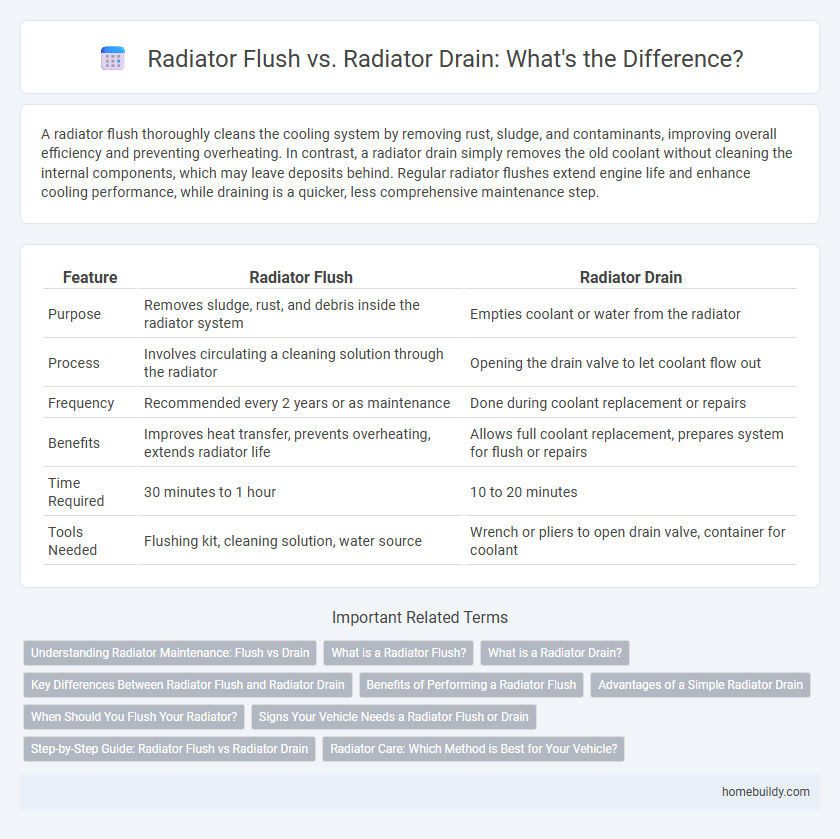A radiator flush thoroughly cleans the cooling system by removing rust, sludge, and contaminants, improving overall efficiency and preventing overheating. In contrast, a radiator drain simply removes the old coolant without cleaning the internal components, which may leave deposits behind. Regular radiator flushes extend engine life and enhance cooling performance, while draining is a quicker, less comprehensive maintenance step.
Table of Comparison
| Feature | Radiator Flush | Radiator Drain |
|---|---|---|
| Purpose | Removes sludge, rust, and debris inside the radiator system | Empties coolant or water from the radiator |
| Process | Involves circulating a cleaning solution through the radiator | Opening the drain valve to let coolant flow out |
| Frequency | Recommended every 2 years or as maintenance | Done during coolant replacement or repairs |
| Benefits | Improves heat transfer, prevents overheating, extends radiator life | Allows full coolant replacement, prepares system for flush or repairs |
| Time Required | 30 minutes to 1 hour | 10 to 20 minutes |
| Tools Needed | Flushing kit, cleaning solution, water source | Wrench or pliers to open drain valve, container for coolant |
Understanding Radiator Maintenance: Flush vs Drain
Radiator flush involves circulating a cleaning solution through the cooling system to remove rust, debris, and old coolant, improving overall performance and preventing overheating. Radiator drain, on the other hand, simply empties the existing coolant without cleaning the system, which is essential before refilling but does not address internal buildup. Regular radiator flushes extend the life of the radiator and engine, while scheduled drains ensure coolant is fresh, both critical for optimal vehicle cooling system maintenance.
What is a Radiator Flush?
A radiator flush is a maintenance procedure that removes built-up rust, scale, sludge, and contaminants from the cooling system to improve engine performance and prevent overheating. This process involves circulating a specialized cleaning solution through the radiator and engine block, effectively dissolving deposits that a simple radiator drain cannot eliminate. Radiator flushes help restore optimal coolant flow and extend the lifespan of the radiator and overall cooling system.
What is a Radiator Drain?
A radiator drain is a valve located at the bottom of a vehicle's radiator designed to allow manual draining of coolant and other fluids for maintenance or repair purposes. It helps remove old or contaminated coolant, preventing corrosion and buildup within the radiator and cooling system. Regular use of the radiator drain ensures optimal engine temperature regulation and prolongs the lifespan of the radiator components.
Key Differences Between Radiator Flush and Radiator Drain
A radiator flush involves using a cleaning solution to remove rust, sludge, and debris from the entire cooling system, improving heat transfer and preventing overheating, while a radiator drain simply removes old coolant from the radiator without cleaning its internal components. Flushing is more thorough and recommended periodically to maintain engine efficiency and extend radiator lifespan, whereas draining is a quicker process mainly done during routine coolant replacement. The key difference lies in flush targeting contaminants to restore radiator performance, unlike drain which only disposes of used coolant.
Benefits of Performing a Radiator Flush
Performing a radiator flush removes built-up rust, scale, and debris from the cooling system, improving heat transfer efficiency and preventing overheating. It enhances coolant flow, reduces the risk of corrosion, and extends the lifespan of the radiator and engine components. Regular flushing maintains optimal engine temperature, leading to better fuel economy and reduced maintenance costs.
Advantages of a Simple Radiator Drain
A simple radiator drain offers the advantage of quick and efficient coolant removal, minimizing downtime during maintenance. This method reduces the risk of contamination by allowing old coolant to be completely expelled, ensuring optimal engine cooling performance. Its straightforward design also lowers the chance of leaks and mechanical failure compared to more complex flushing systems.
When Should You Flush Your Radiator?
Flushing your radiator is essential when you notice signs of overheating, coolant discoloration, or reduced heater performance, typically recommended every 30,000 to 60,000 miles or every 2 to 3 years based on manufacturer guidelines. A radiator flush removes rust, scale, and debris buildup, ensuring optimal coolant flow and preventing corrosion, whereas a radiator drain only removes old coolant without cleaning the system. Performing a flush at these intervals helps maintain engine temperature regulation, prolonging radiator and engine life.
Signs Your Vehicle Needs a Radiator Flush or Drain
Signs your vehicle needs a radiator flush or drain include overheating, coolant discoloration, and a persistent radiator warning light. Sludge or rust buildup inside the radiator indicates the need for a flush to restore cooling efficiency. Low coolant levels or visible leaks suggest a drain and refill to maintain optimal engine temperature control.
Step-by-Step Guide: Radiator Flush vs Radiator Drain
A radiator flush involves completely removing old coolant, cleaning the system with a flushing agent, and refilling with fresh coolant to eliminate rust, debris, and contamination. A radiator drain simply involves opening the drain valve to release old coolant without cleaning the internal system, making it a quicker but less thorough process. For optimal engine cooling system maintenance, performing a step-by-step radiator flush every 30,000 miles or as recommended by the vehicle manufacturer ensures improved heat dissipation and prevents overheating.
Radiator Care: Which Method is Best for Your Vehicle?
Radiator flush effectively removes built-up rust, scale, and contaminants, enhancing cooling system efficiency and preventing overheating, while a radiator drain simply empties old coolant without cleaning internal deposits. Choosing between a flush and drain depends on vehicle condition; a flush is ideal for thorough maintenance every 30,000 miles or when coolant appears discolored, whereas a drain is suitable for routine coolant replacement. Proper radiator care through timely flushing can extend engine life and improve performance by maintaining optimal coolant flow and temperature regulation.
Radiator Flush vs Radiator Drain Infographic

 homebuildy.com
homebuildy.com